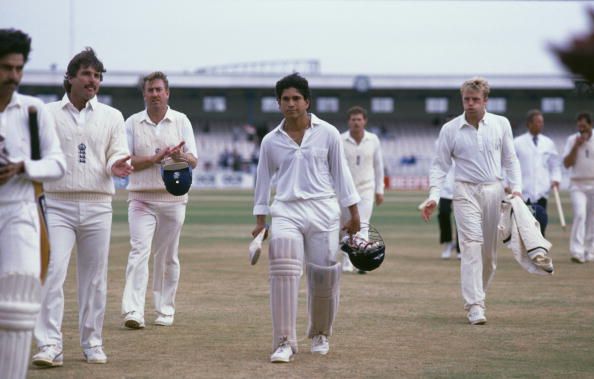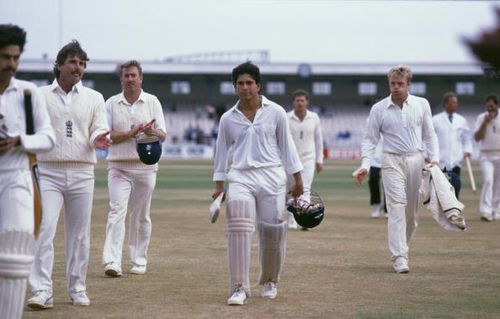
Sachin Tendulkar: A modern epic of mythical proportions

Sachin Tendulkar after hitting his first Test century against England at Old Trafford
The numbers are simply astounding, the longevity is baffling. A quarter century of sustained excellence isn’t something that you’d associate with life at the highest levels of sport. With the probable exception of golfers, even the most prolific professional careers last a decade. Even the divinely gifted Roger Federer is struggling to stretch his reign as he turns the corner.
An incredible career spanning nearly 24 years is a freak of nature worthy of an entire wall inside the National Museum on Janpath. And an entire chapter in the tale of post independent India might struggle to do justice to the immense cultural impact of the great batsman’s voracious collection of works.
His innings straddled across nearly thousand Test matches, between the celebrated debut Test # 1127 in 1989 and the finale in Test # 2102, spanning generations and wooing entire families across the world who were enamoured by his disciplined and insatiable hunt for runs. He walked the world of cricket like a colossus claiming his destiny, leaving an imprint that might stand the test of time.
Invited to a bloody battle against the might of the wily Wasim Akram and a raw Waqar Younis, the 16-year-old Sachin Tendulkar wore his armour like a man possessed. Even as the tender boy strode out purposefully, many like Sunil Gavaskar knew that Sachin was setting off on an expedition that would take him to elevated peaks that few, if any, even knew existed.
It does not take a great deal of intelligence to see that the board in India rarely does anything right. Sometimes though, even the powers that be strike the right note. In an inspired decision, the wise men decided to blood a teenaged toddler into a battle between men. And for once, they had served Indian cricket right.
Just as well, because the little lad needed time, as much of it as possible, to scale imposing mountains and uncover virgin peaks. Cheered on by a billion Indians, Sachin propelled himself to unprecedented glory on the back of immense powers of concentration, dedicated effort and a passionate love for the game that simply would not wane even with advancing years.
The great batsman has made good use of his time at the top of cricket, building a monumental career that could remain unsurpassed for the foreseeable future. Cricket fans anointed Tendulkar the God of cricket. Commentators around the world held their breath at the ease with which he accumulated his runs. It surprised them if he failed to muster runs by the bucketful, never when he collected them in heaps.
He carried the burden of a billion hopes with the ease of a Hercules shouldering a boulder. The people around him – his parents, his brother and his wife – helped Tendulkar remain grounded and focused despite the constant hyperbole that surrounded his existence.
People got hooked early; the irreverence that allowed the lad to dance out of his crease to destroy the deviant genius in Abdul Qadir caught the attention of a generation that was still looking for new heroes. They needed someone to pick up the baton from men like Sunil Gavaskar and Kapil Dev.
On a balmy English day in Old Trafford, Sachin overcame the elements to underline his prominence with a convincing 119* to salvage a draw from a perilous 183-6. But Sachin himself was only convinced that he belonged in the big league much later. It was in 1992 on a fiery Perth track that Sachin finally experienced a sense of complete vindication about his status as an eminent cricketer.
Neither the moustachioed Merv Hughes nor the fit and furious Craig McDermott could move the new little master, even as wickets fell at an alarming pace at the other end. The epochal 114 came off 161 balls, before he became the ninth wicket to fall in that innings. India lost that match and series by a big margin to Australia, but Tendulkar had earned the respect of the world.
Twenty years later, after scoring a bounteous amount of runs against all comers both home and away, Indian cricket has bid adieu to its favourite son. In the long interval between then and now, Tendulkar has seen three generations of cricketers walk on and off the treadmill even as he remained a steady presence on the deck. Just as he was collecting memories on the sands of time, he left an indelible imprint on the burnt souls of a billion fanatic followers.
There was once a wizard that travelled to India in the hope that he could teach his hosts a few new tricks. But Sachin, still only 25, had other ideas. He tore into Shane Warne even before the Aussie could size up his tour flannel.
Tendulkar had decided that he needed to have an early go at the spin maestro. He surprised the Aussies by opting to play the warm up game at Brabourne between Mumbai and the visitors. On the second day of that match, Tendulkar stroked his way to a 90-ball hundred. That wasn’t the point though; scoring runs was only a habit with Sachin. It was the manner of his plunder that left everyone amazed.
Sachin got stuck into Warne as soon as he laid eyes on the path of Warne’s loopy trick. By the end of the day, Mumbai gained more than 100 runs over the visitors and Warne was distraught by the punishment meted to his bowling. The Aussie went for 111 runs off his 16 overs at nearly seven an over. At the other end, another slow bowler – the off spinner Gavin Robertson – was tending to an equally bruised body of figures that saw him spill 96 runs from his 15 overs.
It was to be the day that set the tone for an important series and began a new tradition for India against Australia. Contests between the two teams took on a new hue, drew fans in hordes and created an intense rivalry that is intact even today.
Just at the time when Sachin was orchestrating cricket into a religion, the game was struck a body blow. The betting scandal took down some real heavyweights and cast a net of aspersion on large communities within the cricket fraternity.
It was during those dark times that Sachin, in the company of fine men such as Rahul Dravid, managed to stay clear of the disaster and offer succour through some resolute cricket and a character to match. As the years progressed, Sachin continued to embellish his stature.
The runs continued to flow, even if in spurts unlike the steady stream of the past. The leading batsman of our times was deeply distressed when despite his stellar effort with the bat, India ended up being outplayed by the Aussies in the finals of the coveted World Cup in 2003.
That was also the time when injuries started to plunder his ravaged body. The determined Tendulkar lived through the storm, reiterating his love for the sport even as a growing band of onlookers questioned his relevance to the team. The chorus grew louder especially after the 2007 World Cup, where India performed abysmally to return home early.
Sachin’s desire to see through insult and injury highlighted the great man’s ability to remain motivated despite achieving literally everything that was meant to be. If there was but one hole in the profile of Sachin, it was the absence of a World Cup medal despite being at the top of his game for the longest time imaginable.
The passage of time had robbed his reflexes, but not his desire to extend his life as an international cricketer. Sachin eschewed some of his attacking methods in order to stitch a compromise with time. Even though critics desired his departure, Sachin kept his equanimity in the pursuit of his dreams.
Already 37, Sachin rediscovered a new spring in his step in the summer of 2010. With the World Cup fast approaching, perhaps Tendulkar was driven yet again by a need to underline his relevance in a young and evolving team. After all, winning the World Cup was still one of his biggest and most cherished dreams.
In a year that marked a big resurgence, Sachin played a controlled ODI schedule to help him concentrate on the longer version of the game. He reaped rich rewards that season, runs that must have given the master much gratification even if they lacked the grandeur and artistry of his prime. Sachin collected 1,562 runs at an average of 78.10, including seven centuries and five fifties in 14 Test matches.
In the context of what followed, it was an important season that helped ease the pressure on his shoulders. The rest, as they say, is history, with Sachin living his wildest dream by helping team India hoist the World Cup in front of his own ilk in Mumbai in 2011. It was a fairytale ending that radiated old world romanticism.
But that moment onward, the wait for a grand farewell only intensified once again. Not one to be perturbed or coaxed, Sachin kept his steely focus on the few remaining goals that kept his wheels oiled. The world stood up in awe when the ageing master completed his 100th international century in an ODI against Bangladesh.
With Sachin just two short of a double century of Test matches, it appeared he might achieve yet another landmark away from home. India was scheduled to travel to South Africa for a short Test series. The BCCI might be acutely imperfect, but it isn’t one that misses an opportunity to strike some gold.
The board used the immense power at its disposal to twist and squeeze a two-Test home series against the cash-strapped West Indies to accord the great man a fittingly regal finale. Sensing the mood in the air, Sachin avoided embarrassment by communicating his plan to retire at the end of his 200th Test.
His announcement set off a frenzied rush to celebrate the man and his career – a shower of flowers, specially crafted tickets and commemorative gold coins for the toss were just a few of these expressions. The celebrations were shorter than anticipated, with the Windies failing to raise their game to match the occasion. But while they failed, India joined in exuberant enthusiasm, making grown men shed tears as the everest among batsmen took one final bow.
The silence that gripped Wankhede in the moments immediately after Darren Sammy held on to a blinder into his chest off a thick edge was a fitting tribute. The music touched a shrilling crescendo quickly, as those present realised that this might indeed be the last time they witness their man in a batsman’s fatigue. 74 is a number not many Indians will forget in a hurry.
As soon the as the series is done, India will suffer withdrawal symptoms even as his many million fans cope with their inability to enjoy the game they so loved for the exploits of this monumental cricketer. But eventually the game will lure them back, for sport rarely suffers long enough for one player. And the unmatched high of an athlete’s impossible brilliance will eventually suck in the addicted fan back into its comforting arms.
Many will also hope that the little master can return too, to share his experience and wisdom off the field, even if it is after a well deserved break from the grind and limelight.